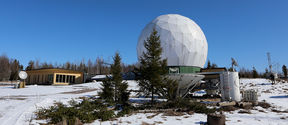Metsähovi Radio Observatory helps reveal the secrets of black holes
Together with other observatories around the world, Aalto University’s Metsähovi Radio Observatory has captured an unprecedented image of a black hole.
TRUE. This statement is true because even light cannot escape from inside a black hole, so it looks black. But a black hole’s surroundings can actually be very bright. Before matter falls into a black hole, it can release an enormous amount of energy, which appears as radiation. For example, when gas falls into a black hole, it usually becomes an accretion disk, moving around the black hole in a spiral orbit. Internal friction causes the disk to heat up, and it can radiate very brightly, liberating energy more efficiently than stars. So a black hole's surroundings may be very bright, but the hole itself is dark.
TRUE. For a very long time, it was thought that such strange beasts couldn’t even exist. Despite theoretical predictions of their existence, people thought some force of nature would prevent the formation of these oddities. But we’ve gathered lots of evidence over the past few decades showing that black holes do exist, and the US space agency NASA estimates that there are about 100 million black holes just in our galaxy, the Milky Way.
But this is also a bit FALSE: even the closest black holes are so far away that they have no impact on our daily lives. The closest black hole to Earth, which has quite a small mass, is about 1,600 light years away, in the constellation Ophiuchus.
Tuomas SavolainenA black hole's surroundings may be very bright, but the hole itself is dark.
The Metsähovi Radio Observatory has been involved in taking pictures of black holes. The most recent image, published this spring, was of the supermassive black hole in the Messier 87 or M87 galaxy in the constellation Virgo, about 55 million light years away. It has a mass of about six billion Suns.
FALSE. A common misconception is that black holes are cosmic hoovers that suck up everything around them. Of course, once you pass a black hole’s ‘boundary’, the event horizon, there’s no going back. That’s where the escape velocity exceeds the speed of light, and past that point no information can escape. But further away, a black hole’s gravity affects its environment no differently than any other object’s gravity – it’s just that the gravity around a black hole is very strong.
On the other hand, it’s TRUE that if, for example, there’s a dense cluster of stars around a black hole at the centre of a galaxy, where the orbits of the stars occasionally interfere with each other, then a star can be caught in an orbit that brings it so close to the black hole that gravitational forces (or tidal forces) act on different parts of the star with different strengths, tearing it apart.
How close is too close?
For the mass of the Sun to become a black hole, it would have to be squeezed into a radius of three kilometres. That’s about the distance between Helsinki’s Central Railway Station and Pasila Station. So if you were coming by train from the north, you could still turn back before Pasila. But at Pasila, you would pass the event horizon and be inside the black hole – and then there would be no turning back.
So what would happen if you fell into a black hole?
It depends on the mass of the black hole. In the case of a small black hole – say, with a mass of several Suns – the tidal forces outside the event horizon would be so strong that you would be stretched into spaghetti-like strands before you reached the event horizon. The tidal forces come from the difference in how strongly gravity pulls on the parts of your body that are closer and further from the black hole. If you were falling feet first, your legs would feel a much stronger pull than your head, so you would get stretched thinner and thinner – and that would be the end of you.
Tuomas SavolainenThere's no need to worry about our Sun becoming a black hole.
The event horizon of more massive black holes is much further away, so you wouldn't necessarily experience the same kind of tidal pull. You might even pass the event horizon without really noticing it. But after that, you wouldn’t be able to escape, and you’d eventually get pulled into spaghetti inside the massive black hole.
FALSE. A star can only become a black hole if it is very massive – at least several tens of Suns in mass. So there's no need to worry about our Sun becoming a black hole.
A star normally produces energy by fusing hydrogen into helium in its core. In very massive stars, the core’s temperature and pressure get so high that the fusion of heavier elements starts, and at the end of its life the star forms an iron core. At this point, fusion reactions stop happening in the core of a very massive star, and there’s no longer enough outward radiation pressure to resist the star’s gravitational force. The star becomes unstable, its inner parts collapse, and its outer parts explode into space as a supernova.
The collapsing inner part can become a black hole. However, this doesn’t happen with stars around the mass of the Sun. Instead of becoming a black hole, once the Sun has blown its outer shell into space, it will turn into a slowly cooling white dwarf star.
FALSE. As with any other space research, black hole research starts from our endless curiosity to understand how our world works. But black hole research is also a way to investigate gravity in very strong gravitational fields, which is not possible on Earth.
Black hole research can answer the persistent question of whether Albert Einstein’s theory of general relativity works in all circumstances. It seems to have worked so far, but we also know that general relativity can’t be the ultimate theory of gravity because it doesn’t play well with quantum mechanics. Quantum mechanics describes the world on the scale of the very small – atoms and elementary particles – but it doesn’t work in the curved space-time described by general relativity. To have a complete understanding of how gravity works – that is, what kind of force it is – we need to be able to combine quantum mechanics and general relativity. Physicists still haven’t succeeded in that despite decades of trying. Black holes offer a potential laboratory in which we can get clues about how general relativity might need to be modified. Black hole research can thus help us better understand fundamental physics, which could have all sorts of applications in the distant future.
Black hole research also leads to the development of new technologies. As astronomers strive to make ever more challenging observations, they rely on technological advances. Astronomy often leads to inventions that end up in everyday use. A good example from radio astronomy is wifi, or wireless networking. Some of its key components were first developed at the Radio Observatory in Westerbork in the Netherlands and then further developed at the Australian Radio Physics Research Institute. So you can't say that black hole research isn't useful, because it also leads to practical inventions – even if only indirectly.


Together with other observatories around the world, Aalto University’s Metsähovi Radio Observatory has captured an unprecedented image of a black hole.

Aalto’s Metsähovi Radio Observatory took part in capturing the new image.

Aalto University contributed to paradigm-shifting observations of the gargantuan black hole at the heart of distant galaxy Messier 87

Next up for the researchers is recording a video of gas entering the black hole.

